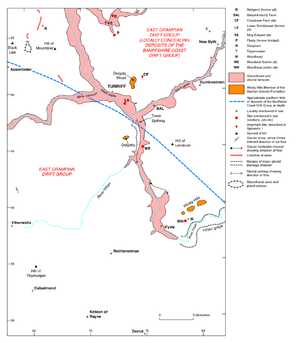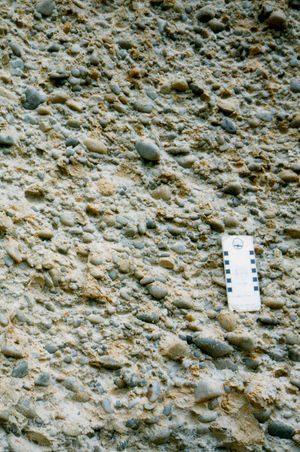Sand and gravel resources, Sheet 86E Turriff, Cainozoic of north-east Scotland
| Merritt, J W, Auton, C A, Connell, E R, Hall, A M, and Peacock, J D. 2003. Cainozoic geology and landscape evolution of north-east Scotland. Memoir of the British Geological Survey, sheets 66E, 67, 76E, 77, 86E, 87W, 87E, 95, 96W, 96E and 97 (Scotland).
Contributors: J F Aitken, D F Ball, D Gould, J D Hansom, R Holmes, R M W Musson and M A Paul. |
Sheet 86E Turriff

The principal resources of sand and gravel on this sheet (P915375) underlie high-level (glaciofluvial) and lower lying (alluvial) terraces within the valleys of the River Deveron and its main tributaries, the Idoch Water and the Burn of Fishrie. Similar, but less extensive deposits flank the ‘misfit’ valley (Towie Spillway) between Turriff and Fyvie. Significant resources of quartz-rich gravel are also present within outliers of the Neogene Windy Hills Gravels Member of the Buchan Gravels Formation at Windy Hills (P104101, P104102), north-east of Fyvie; other smaller outliers occur at Dalgatty Wood and Delgaty near Turriff.


Minor scattered resources of gravel and sand form eskers and small kames in the Alvah–Rosyburn area, and moundy topography along the valley of the Idoch Water, in the vicinity of Balquhindachy Farm (NJ 763 487). Deeply weathered Devonian conglomerates within the Crovie Sandstone Group constitute a minor resource of clayey bouldery gravel in the Turriff–Fyvie area and flat-lying spreads of waterlogged sand and gravel occur within the alluvium and alluvial terraces of the River Ythan and its headwater tributaries.
The deposits underlying the high-level terraces in the Deveron catchment vary considerably in composition. Till, with pockets of sand and gravel, underlies the terraces in the Deveron valley to the north of Turriff. Most of the glaciofluvial terraces around the town itself are composed of sand, with subordinate amounts of gravel, composed of psammitic, pelitic, and granitic clasts, as well as pebbles of sandstone. Gravels predominate upstream of Turriff and along the course of the Burn of King Edward. Clasts of psammitic metamorphic rocks and sandstone characterise the King Edward deposits; slate, feldspar-porphyry and decomposed basic igneous rock clasts are additional components of the gravels in the upper Deveron valley.

Gravels within the northern part of Towie Spillway are poorly sorted and composed of subrounded clasts of granite, sandstone, and chert, as well as of psammitic and pelitic metamorphic rocks. Towards Fyvie, the gravels are mostly composed of rounded clasts of quartzite and sandstone, which are largely derived from the underlying Devonian conglomerate bedrock. The gravel deposit at Windy Hills was evaluated in MAR 76 (Merritt, 1981) and is described in detail in Site 13 Windyhills. More than 95 per cent (by weight) of this cobbly deposit is formed of water-worn clasts of white vein quartz and quartzite (P915335). The deposit at Delgaty contains a notable proportion of brown sandstone pebbles in addition to the predominant quartzose clasts, whereas the Dalgatty Wood deposit contains notable amounts of white sand; neither has been the subject of detailed assessment.